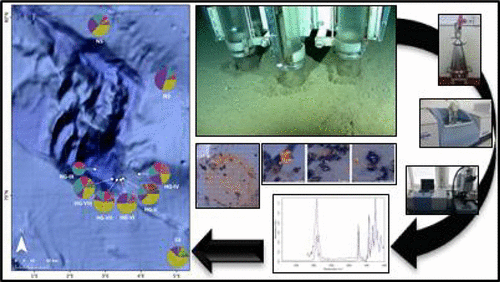当前位置:
X-MOL 学术
›
Environ. Sci. Technol.
›
论文详情
Our official English website, www.x-mol.net, welcomes your feedback! (Note: you will need to create a separate account there.)
High Quantities of Microplastic in Arctic Deep-Sea Sediments from the HAUSGARTEN Observatory
Environmental Science & Technology ( IF 11.4 ) Pub Date : 2017-09-11 00:00:00 , DOI: 10.1021/acs.est.7b03331 Melanie Bergmann 1 , Vanessa Wirzberger 2, 3 , Thomas Krumpen 4 , Claudia Lorenz 2 , Sebastian Primpke 2 , Mine B. Tekman 1 , Gunnar Gerdts 2
Environmental Science & Technology ( IF 11.4 ) Pub Date : 2017-09-11 00:00:00 , DOI: 10.1021/acs.est.7b03331 Melanie Bergmann 1 , Vanessa Wirzberger 2, 3 , Thomas Krumpen 4 , Claudia Lorenz 2 , Sebastian Primpke 2 , Mine B. Tekman 1 , Gunnar Gerdts 2
Affiliation

|
Although mounting evidence suggests the ubiquity of microplastic in aquatic ecosystems worldwide, our knowledge of its distribution in remote environments such as Polar Regions and the deep sea is scarce. Here, we analyzed nine sediment samples taken at the HAUSGARTEN observatory in the Arctic at 2340–5570 m depth. Density separation by MicroPlastic Sediment Separator and treatment with Fenton’s reagent enabled analysis via Attenuated Total Reflection FTIR and μFTIR spectroscopy. Our analyses indicate the wide spread of high numbers of microplastics (42–6595 microplastics kg–1). The northernmost stations harbored the highest quantities, indicating sea ice as a possible transport vehicle. A positive correlation between microplastic abundance and chlorophyll a content suggests vertical export via incorporation in sinking (ice-) algal aggregates. Overall, 18 different polymers were detected. Chlorinated polyethylene accounted for the largest proportion (38%), followed by polyamide (22%) and polypropylene (16%). Almost 80% of the microplastics were ≤25 μm. The microplastic quantities are among the highest recorded from benthic sediments. This corroborates the deep sea as a major sink for microplastics and the presence of accumulation areas in this remote part of the world, fed by plastics transported to the North via the Thermohaline Circulation.
中文翻译:

豪斯加登天文台的北极深海沉积物中大量微量塑料
尽管越来越多的证据表明,微塑料在全球水生生态系统中无处不在,但我们对它在极地地区和深海等偏远环境中分布的了解却很少。在这里,我们分析了从北极的HAUSGARTEN天文台在2340-5570 m深度处采集的九个沉积物样本。通过微塑料沉积物分离器进行密度分离,并通过Fenton试剂进行处理,可通过衰减全反射FTIR和μFTIR光谱进行分析。我们的分析表明,大量的微塑料(42–6595微米塑料kg –1)广泛传播。最北端的站位数量最多,表明海冰可能是一种运输工具。微塑性丰度与叶绿素a的正相关内容表明通过并入沉没的(冰)藻类聚集体进行垂直出口。总体上,检测到18种不同的聚合物。氯化聚乙烯占最大比例(38%),其次是聚酰胺(22%)和聚丙烯(16%)。几乎80%的微塑料≤25μm。底栖沉积物中的微量塑料含量最高。这证实了深海是微塑料的主要汇聚地,并且在世界的这个偏远地区存在着聚集区域,这些区域由通过热盐循环输送到北部的塑料提供。
更新日期:2017-09-11
中文翻译:

豪斯加登天文台的北极深海沉积物中大量微量塑料
尽管越来越多的证据表明,微塑料在全球水生生态系统中无处不在,但我们对它在极地地区和深海等偏远环境中分布的了解却很少。在这里,我们分析了从北极的HAUSGARTEN天文台在2340-5570 m深度处采集的九个沉积物样本。通过微塑料沉积物分离器进行密度分离,并通过Fenton试剂进行处理,可通过衰减全反射FTIR和μFTIR光谱进行分析。我们的分析表明,大量的微塑料(42–6595微米塑料kg –1)广泛传播。最北端的站位数量最多,表明海冰可能是一种运输工具。微塑性丰度与叶绿素a的正相关内容表明通过并入沉没的(冰)藻类聚集体进行垂直出口。总体上,检测到18种不同的聚合物。氯化聚乙烯占最大比例(38%),其次是聚酰胺(22%)和聚丙烯(16%)。几乎80%的微塑料≤25μm。底栖沉积物中的微量塑料含量最高。这证实了深海是微塑料的主要汇聚地,并且在世界的这个偏远地区存在着聚集区域,这些区域由通过热盐循环输送到北部的塑料提供。


























 京公网安备 11010802027423号
京公网安备 11010802027423号